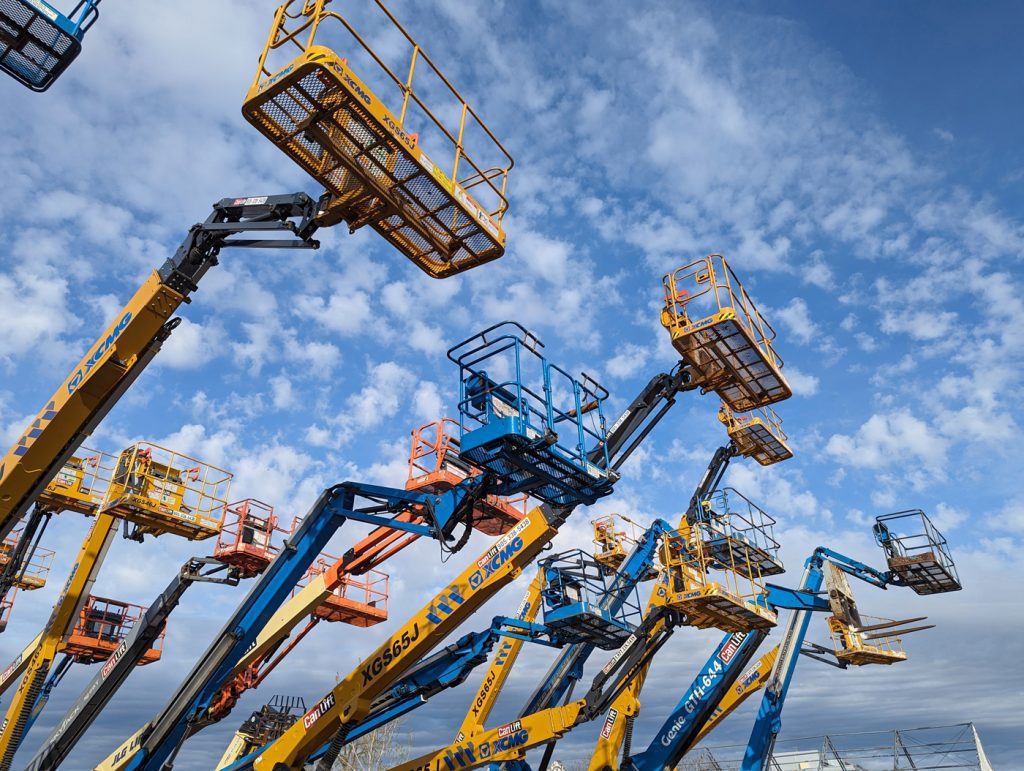Monday, August 12th, 2024
Renting vs. Buying Lifts: Which Is Right for Your Project?

Whether you’re starting a new project or expanding your existing scope, one thing is clear—you need the right equipment to get the job done. Buying equipment outright isn’t always the best option for your business and making the right choice between renting and buying can significantly impact both your budget and project efficiency. This leads us to the question: should you rent or buy your lift equipment?
The Case for Renting Lift Equipment
In May 2024, the total investment in building construction in Canada reached an impressive $20.8 billion. Given the industry’s scale and impact, making informed decisions about equipment acquisition is crucial.
As one of Ontario’s largest independently-owned lift equipment providers, CanLift has noticed a growing trend—more businesses are preferring flexible equipment solutions. In an 18-month period, CanLift invested over $40 million in new fleet equipment and expanded its delivery capabilities with ten trucks transporting rental gear across the province.
So, why are more businesses leaning towards renting? Let’s break it down.
- Cost Savings and Flexibility
Renting lift equipment can save you a significant amount of money, especially for short-term projects or those with changing demands. When you rent, you avoid the high upfront costs that come with purchasing, allowing you to allocate your capital more effectively. This can greatly improve your cash flow and overall financial flexibility. Simply put, renting lets you pay for what you need, when you need it, without tying up your funds in a long-term investment.
- No Maintenance Costs
One of the most compelling reasons to rent is that maintenance and repair costs are usually included in the rental agreement. This not only saves you money but also reduces the administrative burden on your team. Instead of worrying about equipment upkeep, your team can stay focused on what they do best—delivering on your project.
- Scalability and Reduced Storage Needs
Projects can be unpredictable, and your equipment needs can change from month to month or even week to week. Renting allows you to easily scale your fleet up or down based on what’s required. Plus, you don’t have to worry about finding space for idle equipment or dealing with the costs of long-term storage. When the project ends, you simply return the equipment.
- Access to Specialized Equipment
Some projects require specialized or niche equipment that you may not use frequently enough to justify a purchase. Renting gives you access to the latest models and technologies without committing to a long-term investment. This ensures you always have the best tools for the job without the hefty price tag, whether it’s renting forklifts, aerial lifts or material handling equipment.
- ‘Try Before You Buy’
Thinking about expanding your fleet or transitioning to new technology? Renting allows you to test different types of equipment in real-world conditions before making a long-term commitment. It’s like taking a car for a test drive—only better because you’re using it on the actual job site.
See testimonials from CanrLift’s valued clients.
When Buying Makes Sense
While renting offers numerous benefits, there are scenarios where buying might be the better option. For long-term projects, such as multi-year constructions or manufacturing plants, owning equipment could be more cost-effective in the long run. Ownership gives you an asset base, unlimited use, the ability to customize, brand familiarity, and potential tax benefits, making it a solid investment for projects with stable, high-frequency needs.
Making the Right Choice
When deciding whether to buy or rent lifts, it’s important to consider the following factors:
- Frequency of Use: How often will you need the equipment?
- Project Duration: Is this a short-term or long-term project?
- Budget and Cash Flow: Do you have the capital for a significant upfront investment or would you benefit from spreading costs over time?
- Maintenance and Repairs: Are you equipped to handle maintenance and repair?
- Equipment Flexibility: Do you need specialized equipment for specific tasks?
- Depreciation and Resale Value: How will the equipment’s value change over time?
- Storage and Logistics: Do you have the facilities to store the equipment securely?
- Tax Implications: Can you take advantage of any tax benefits from purchasing?
- Company Growth and Scalability: Are your equipment needs likely to change in the near future?
Explore CanLift’s Equipment Inventory to find the perfect solution for your project.
CanLift’s Commitment to Your Success
At CanLift, we understand that every project is unique, and so are your equipment needs. Whether you’re leaning towards short-term solutions or expanding your fleet, we’re here to support businesses across Ontario with services that ensure you get the best value for your investment.



